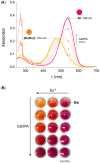Beetroot-pigment-derived colorimetric sensor for detection of calcium dipicolinate in bacterial spores
- PMID: 24019934
- PMCID: PMC3760816
- DOI: 10.1371/journal.pone.0073701
Beetroot-pigment-derived colorimetric sensor for detection of calcium dipicolinate in bacterial spores
Abstract
In this proof-of-concept study, we describe the use of the main red beet pigment betanin for the quantification of calcium dipicolinate in bacterial spores, including Bacillus anthracis. In the presence of europium(III) ions, betanin is converted to a water-soluble, non-luminescent orange 1∶1 complex with a stability constant of 1.4 × 10(5) L mol(-1). The addition of calcium dipicolinate, largely found in bacterial spores, changes the color of the aqueous solution of [Eu(Bn)(+)] from orange to magenta. The limit of detection (LOD) of calcium dipicolinate is around 2.0 × 10(-6) mol L(-1) and the LOD determined for both spores, B. cereus and B. anthracis, is (1.1 ± 0.3)× 10(6) spores mL(-1). This simple, green, fast and low cost colorimetric assay was selective for calcium dipicolinate when compared to several analogous compounds. The importance of this work relies on the potential use of betalains, raw natural pigments, as colorimetric sensors for biological applications.
Conflict of interest statement
Figures





Similar articles
-
Eriochrome Black T-Eu3+ Complex as a Ratiometric Colorimetric and Fluorescent Probe for the Detection of Dipicolinic Acid, a Biomarker of Bacterial Spores.Anal Chem. 2018 Mar 20;90(6):4221-4225. doi: 10.1021/acs.analchem.8b00576. Epub 2018 Mar 7. Anal Chem. 2018. PMID: 29488375
-
Ratiometric luminescent detection of bacterial spores with terbium chelated semiconducting polymer dots.Anal Chem. 2013 Oct 1;85(19):9087-91. doi: 10.1021/ac4016616. Epub 2013 Sep 20. Anal Chem. 2013. PMID: 23964730
-
Dual colorimetric and luminescent assay for dipicolinate, a biomarker of bacterial spores.Analyst. 2013 Dec 7;138(23):7079-82. doi: 10.1039/c3an01658g. Epub 2013 Oct 8. Analyst. 2013. PMID: 24106737 Free PMC article.
-
Red Beetroot Betalains: Perspectives on Extraction, Processing, and Potential Health Benefits.J Agric Food Chem. 2020 Oct 21;68(42):11595-11611. doi: 10.1021/acs.jafc.0c04241. Epub 2020 Oct 11. J Agric Food Chem. 2020. PMID: 33040529 Review.
-
Recent developments in emerging technologies for beetroot pigment extraction and its food applications.Food Chem. 2021 Sep 15;356:129611. doi: 10.1016/j.foodchem.2021.129611. Epub 2021 Mar 19. Food Chem. 2021. PMID: 33838608 Review.
Cited by
-
An Update on the Use of Natural Pigments and Pigment Nanoparticle Adducts for Metal Detection Based on Colour Response.Biosensors (Basel). 2023 May 18;13(5):554. doi: 10.3390/bios13050554. Biosensors (Basel). 2023. PMID: 37232915 Free PMC article. Review.
-
Development of paper based colorimetric method using pigment from red dragon fruit for determination of Cu and Fe.Sci Rep. 2025 Apr 19;15(1):13522. doi: 10.1038/s41598-025-98693-7. Sci Rep. 2025. PMID: 40253539 Free PMC article.
-
Rationale on the High Radical Scavenging Capacity of Betalains.Antioxidants (Basel). 2019 Jul 13;8(7):222. doi: 10.3390/antiox8070222. Antioxidants (Basel). 2019. PMID: 31337048 Free PMC article.
-
Reannotation of Fly Amanita l-DOPA Dioxygenase Gene Enables Its Cloning and Heterologous Expression.ACS Omega. 2022 Apr 25;7(18):16070-16079. doi: 10.1021/acsomega.2c01365. eCollection 2022 May 10. ACS Omega. 2022. PMID: 35571802 Free PMC article.
References
-
- Vilas-Boas GT, Peruca APS, Arantes OMN (2007) Biology and taxonomy of Bacillus cereus, Bacillus anthracis, and Bacillus thuringiensis. Can J Microbiol 53: 673–687. - PubMed
-
- Inglesby TV, Henderson DA, Bartlett JG, Ascher MS, Eitzen E, et al. (1999) Anthrax as a biological weapon: Medical and public health management. JAMA, J Am Med Assoc 281: 1735–1745. - PubMed
-
- Inglesby TV, O’Toole T, Henderson DA, Bartlett JG, Ascher MS, et al. (2002) Anthrax as a biological weapon, 2002: Updated recommendations for management. JAMA, J Am Med Assoc 287: 2236–2252. - PubMed
-
- Sanderson WT, Stoddard RR, Echt AS, Piacitelli CA, Kim D, et al. (2004) Bacillus anthracis contamination and inhalational anthrax in a mail processing and distribution center. J Appl Microbiol 96: 1048–1056. - PubMed
Publication types
MeSH terms
Substances
LinkOut - more resources
Full Text Sources
Other Literature Sources

